The research paper published by IJSER journal is about Modelling and Simulation of Trajectories of a Wire Like Particle in a Three Phase Common Enclosure Gas Insulated Busduct (GIB) with Image Charges 1
ISSN 2229-5518
Modelling and Simulation of Trajectories of a Wire Like Particle in a Three Phase Common Enclosure Gas Insulated Bus duct (GIB) with Image Charges
M. Siva Sathyanarayana1, J.Amarnath2
1Jawaharlal Nehru Technological University, Hyderabad, Andhra Pradesh, India
Sathya_varma@Rediffmail.com
Abstract: In recent years, SF6 gas insulated switchgear (GIS) has become more widespread in electrical power substations and GIS rated from 66 to 1100kV are working successfully. The GIS is used in closed vessels, isolated from the atmosphere. This gives it intrinsically high insulation reliability because there is no contact with dirt or contaminates. To assure even better reliability, measures must be taken against metallic particle contamination. Some of these in use include changes in the manufacturing environment, modification of the structures, careful cleaning of the GIS both during and after assembling, etc. Even at most measures are taken to eliminate particle contamination effect metallic particle contamination in a compressed Gas Insulated Busduct (GIB) system Is inevitable and may substantially lower the corona onset and breakdown voltages of the system. The random movement of metallic particles in a GIB system plays a crucial role in determining the insulation performance of the system. In this study a statistical approach has been used to evaluate the probability of SF6 insulation breakdown due to the presence of contaminating metallic particles. Under 50-Hz AC voltage, the particle motion is complex, and under appropriate conditions, the particle may cross the gaseous gap from the low- field region near the outer enclosure to the high-field region near the central conductor. For the commonly encountered size of metallic particles in practical Gas Insulated systems, such a crossing of the gaseous gap takes several cycles of the 50-Hz voltage. In order to determine the particle trajectories in a three- phase common enclosure GIB) an outer enclosure of diameter
500 mm and inner conductors of diameters 64 mm spaced equilaterally are considered. Wire like particles of aluminum and copper has been considered to be present on enclosure surface of a three-phase bus duct. A method based on particle movement is proposed to determine the particle trajectory in GIS or GIB for a three phase common enclosure while the image charge effects of
the conductors are considered. The motion of the wire particle was simulated using the charge acquired by the particles, the macroscopic field at the particle site, the drag coefficient, Reynold’s number and coefficient of restitution. The computation of particle movement has been carried out on bare electrode system for different voltages. The results have been presented and analyzed.
I. INTRODUCTION
It is well known that metallic particle contamination in a compressed Gas Insulated Busduct (GIB) system may lower the corona onset and breakdown voltage of the system considerably Metallic particles move randomly in a horizontally mounted GIB system due to the electric field, and this movement plays a crucial role in determining the insulation behavior of GITL systems. Under 50 Hz ac voltage the particle motion is complex since the driving force acting on the particle periodically changes its direction and is not constant. After the particle is elevated against gravity, the characteristic particle motion is dependent on the applied voltage level and particle parameters, i.e., shape, size and material. For the commonly encountered size of metallic particles in practical GIB systems, such a crossing of the gaseous gap takes several cycles of the 50 Hz voltage. The movement of spherical and wire particles has been investigated by the authors using a computational algorithm taking into account the effect of drag force on the particle motion in several horizontally mounted coaxial electrode systems. Under an applied 50 Hz AC voltage a metallic particle's ability to cross the inter-electrode gap may be
characterized by the minimum peak AC voltage necessary for
IJSER © 2012
http://www.ijser.org
The research paper published by IJSER journal is about Modelling and Simulation of Trajectories of a Wire Like Particle in a Three Phase Common Enclosure Gas Insulated Busduct (GIB) with Image Charges 2
ISSN 2229-5518

the crossing. An idealized wire particle is shown in Fig. 1. The shape and physical dimensions of a particle affect the minimum crossing voltage, at a given pressure. As the particle radius increases, the drag forces increase, thus raising the voltage necessary for the crossing. On the other hand, as the net charge on the particle increases with the radius, the electrostatic driving force also increases, thus reducing the voltage necessary for the crossing. It is known that wire particles, under a 50 Hz AC field, may remain in the mid-gap region in a GIB system for several cycles. They may be charged by one electrode at the maximum voltage during one half-cycle, and return to the electrode at the peak voltage of opposite polarity, thus causing micro discharges.
Fig1. Basic wire like particle
This presentation is focused on the motion of elongated particles, since these particles are considered the ones most frequently found in GIS [1]. The aim of the work has been to learn more about the motion and thereby to suggest improvements to the models that traditionally have been used. With a good model, a more accurate calculation of the motion of a particle and, in turn, a better estimation about its severity in a system can be made.
A metallic particle is lifted from a resting position on a grounded electrode and kept in motion by the electrostatic force, which basically equals the product of the surrounding electric field and the charge carried by the particle. The voltage required to lift the particle is often well below the operating voltage level of the system. Once the particle lifts from the surface, it moves in the direction of the electric field. Unless the applied field changes its direction or magnitude,
the particle hits the inner electrode of the system, where it gets
a new net charge. The magnitude of the net charge depends, besides the dimension of the particle, on the value of the surrounding field at the time of impact with the electrode [2]. For an ac field, one may expect the motion of a particle to be random-like, since the charge on the particle interacts with the continuously changing electric field. Also, since the charge on it depends on when it hits the electrodes, the charge varies after each consecutive impact. However, by statistical analysis of the time between impacts of the particle with the enclosure, one can find that the motion of the particle is, in fact, influenced by the power frequency [3,4]. For an applied ac field, the maximum height that the particle can elevate from the electrode is limited compared with a dc field. If the applied voltage is sufficient, several voltage cycles might be necessary for the particle to be able to cross the gap.
Experimental studies have shown that the probability of breakdown for elongated particles is highest when the particle is located close to (< 2 mm) but not in contact with the inner electrode [5]. The voltage breakdown during such an event is assumed to start when a small discharge first bridges the distance from the inner electrode to the particle, which brings the particle to the same potential as the inner electrode. A discharge then bridges the rest of the gap since the particle, at that position, acts as a protrusion on the inner electrode, pointing towards ground. Discharges from the sharp ends of a particle, often referred to as in-flight corona, can also occur if conditions for corona inception are fulfilled [6-8]. In this case, the particle can modify its carried charge between impacts with the electrodes.
II. MODELLING TECHNIQUE
Typical horizontal three-phase bus duct shown in
Figure 2 has been considered for the analysis.
IJSER © 2012
http://www.ijser.org
The research paper published by IJSER journal is about Modelling and Simulation of Trajectories of a Wire Like Particle in a Three Phase Common Enclosure Gas Insulated Busduct (GIB) with Image Charges 3
ISSN 2229-5518

Fig 2. Horizontal Three Phase Bus Duct
Understanding the dynamics of a metallic particle in a coaxial electrode system is of vital importance for determining the effect of metallic contamination in a Gas Insulated System. If the motion pattern of a metallic particle is known, the probability of particle crossing a coaxial gap and causing a flashover can be estimated. The lift-off field for a particle on the surface of an electrode can be estimated by solving the motion equation.
A conducting particle in motion in an external electric field will be subjected to a collective influence of several forces. The forces may be divided into Electrostatic force (FE), Gravitational force (mg) and Drag force (Fd). Figure 3 shows a horizontal three phase bus duct comprising of inner conductors spaced equilaterally in a metal enclosure with images. The enclosure is filled with SF6 gas at a high pressure (0.3MPa). A particle is assumed to be at rest at the enclosure surface, just beneath the bus bar 2, until a voltage sufficient enough to lift the particle and move in the field is applied. After acquiring an appropriate charge in the field, the particle lifts and begins to move in the direction of field having overcome the forces due to its own weight and drag. The simulation considers several parameters e.g. the macroscopic field at the surface of the particle, its weight, Reynold‟s number, coefficient of restitution on its impact to both enclosures and viscosity of the gas. During return flight, a new charge on the particle is assigned based on the instantaneous electric field.
Total electrical field intensity at the point „P‟ is





E E1 E2 E3
1 1
V
h x h x
2h
Cos 2
V2
R1
Cos 2
R2
2h
Cos 2
V3
R1
Cos 2
R2
2h
2 ln
r
2 ln
r
2 ln
r



1 1 1
V
2ln(2h/r) h x h x
V/mm
Cosθ 2
R1
Cosγ 2
R 2
(V2


V3 )
Where V1, V2, V3 are the three phase voltages given by
Figure 3. Three Phase Common Enclosure Bus Duct with
Image Charges


V1 Vm Sin t


V2 Vm Sin( t


V3 Vm Sin( t
120 )
240 )
IJSER © 2012
http://www.ijser.org
The research paper published by IJSER journal is about Modelling and Simulation of Trajectories of a Wire Like Particle in a Three Phase Common Enclosure Gas Insulated Busduct (GIB) with Image Charges 4
ISSN 2229-5518
1 1
VmSin ωi
1 h x h x

E

The above equation is a second order non-linear equation which is solved using Ranga Kutta 4th order method
is adopted.
2ln(2h/r)
Cosθ 2
R1
Cosγ 2
R 2
(VmSin( ωi

120)

VmSin( ωi

240))
III. SIMULATION RESULTS AND ANALYSIS
The motion equation is
2
Table I gives the values of maximum radial movement of a aluminum and copper type of wire like particle
of length 4mm with variable radius 0.1mm, 0.2mm and 0.3mm



m d y F F mg
Where
dt 2 e d
when applied with three different voltages 400KV, 450KV
and 500KV. The corresponding particle movement for aluminum and copper type of particles is presented in Fig 4 to
Fd = Drag force
mg = Force due to gravitation.

F e = Electrostatic force = q E
Fig 18 for varying radius of the particle and different applied voltages.
Where
E is the Electrostatic field intensity in three phase
Table I. Radial Movement of a Wire like particle with fixed length of l=4mm and variable radius of 0.1mm, 0.2mm and
0.3mm
GIS taking the image charge effect of the conductor into
consideration

q is the charge of the particle.
my t
πε0l
2
E t 0
Vsin ωs
2l
ln 1
r
r0 r0 y t ln
i
mg y
t πr 6μμ d y
2.656 μρ g ly
t 0.5
my t
πε0l
2
E t 0
V 243.2
1000
1
125
2l
ln 1
r
1
x 125 x
Cosγ 2
R 2
Cosθ1
R1


Sin ωi mg
y t
πr 6μμ d y
2.656 μρ g ly
t 0.5
IJSER © 2012
http://www.ijser.org
The research paper published by IJSER journal is about Modelling and Simulation of Trajectories of a Wire Like Particle in a Three Phase Common Enclosure Gas Insulated Busduct (GIB) with Image Charges 5
ISSN 2229-5518


35 35
30 30
25 25
20
20
15
15
10
5
0
0 0.2 0.4 0.6 0.8 1 1.2
-5
Time(Sec)
10
5
0
0 0.2 0.4 0.6 0.8 1 1.2
-5
Time(Sec)
Fig.4 Particle Movement in a 3-phase 500/64 GIB with images for 400KV/AL/4mm/0.1mm radius.

Fig.6 Particle Movement in a 3-phase 500/64 GIB with images for 450KV/AL/4mm/0.1mm radius.
5
4.5
9

4
8
3.5
7
3
6
2.5 5
2 4
1.5 3
1
0.5
0
0 0.1 0.2 0.3 0.4 0.5 0.6 0.7 0.8 0.9 1
Time(Sec)
2
1
0
0 0.1 0.2 0.3 0.4 0.5 0.6 0.7 0.8 0.9 1
-1
Time(Sec)
Fig.5 Particle Movement in a 3-phase 500/64 GIB with images for 400KV/Cu/4mm/0.1mm radius.
Fig.7 Particle Movement in a 3-phase 500/64 GIB with images for 450KV/Cu/4mm/0.1mm radius.
IJSER © 2012
http://www.ijser.org
The research paper published by IJSER journal is about Modelling and Simulation of Trajectories of a Wire Like Particle in a Three Phase Common Enclosure Gas Insulated Busduct (GIB) with Image Charges 6
ISSN 2229-5518
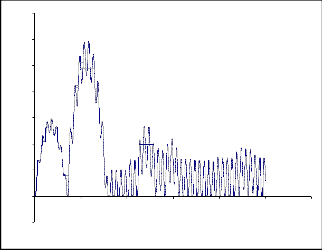
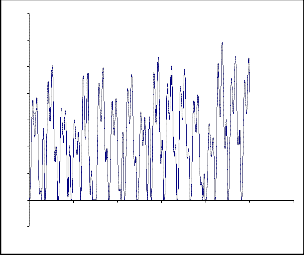
70 7
60 6
50 5
40 4
30 3
20 2
10 1
0
-10
0 0.2 0.4 0.6 0.8 1 1.2
Time(Sec)
0
0 0.2 0.4 0.6 0.8 1 1.2
-1
Time(Sec)
Fig.8 Particle Movement in a 3-phase 500/64 GIB with images for 500KV/AL/4mm/0.1mm radius.
Fig.10 Particle Movement in a 3-phase 500/64 GIB with images for 400KV/AL/4mm/0.2mm radius.

12
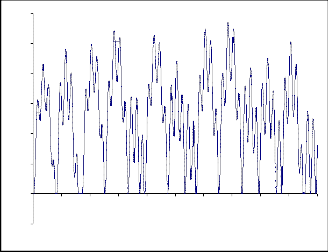
10
10 9
8
8
7
6
4
2
0
0 0.1 0.2 0.3 0.4 0.5 0.6 0.7 0.8 0.9 1
-2
Time(Sec)
6
5
4
3
2
1
0
0 0.2 0.4 0.6 0.8 1 1.2
-1
Time(Sec)
Fig.9 Particle Movement in a 3-phase 500/64 GIB with images for 500KV/Cu/4mm/0.1mm radius.
Fig.11 Particle Movement in a 3-phase 500/64 GIB with images for 450KV/AL/4mm/0.2mm
IJSER © 2012
http://www.ijser.org
The research paper published by IJSER journal is about Modelling and Simulation of Trajectories of a Wire Like Particle in a Three Phase Common Enclosure Gas Insulated Busduct (GIB) with Image Charges 7
ISSN 2229-5518
1.6
2.5
1.4
2
1.2
1 1.5
0.8
1
0.6
0.4
0.5
0.2
0
-0.2
0 0.1 0.2 0.3 0.4 0.5 0.6 0.7 0.8 0.9 1
Time(Sec)
0
-0.5
0 0.1 0.2 0.3 0.4 0.5 0.6 0.7 0.8 0.9 1
Time(Sec)
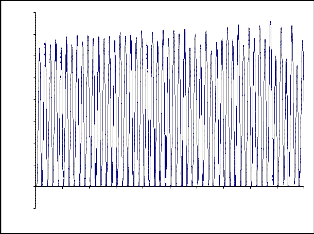
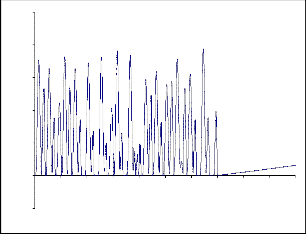
Fig.12 Particle Movement in a 3-phase 500/64 GIB with images for 450KV/Cu/4mm/0.2mm
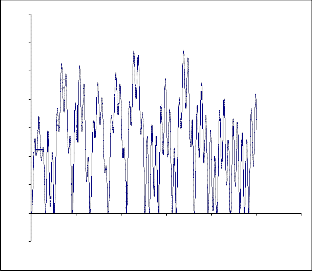
Fig.14 Particle Movement in a 3-phase 500/64 GIB with images for 500KV/Cu/4mm/0.2mm
14
12
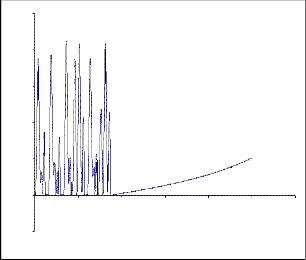
10 2.5
8 2
6
1.5
4
1
2
0
0 0.2 0.4 0.6 0.8 1 1.2
-2
Time(Sec)
Fig.13 Particle Movement in a 3-phase 500/64 GIB with images for 500KV/AL/4mm/0.2mm
0.5
0
-0.5
0 0.2 0.4 0.6 0.8 1 1.2
Time(Sec)
Fig.15 Particle Movement in a 3-phase 500/64 GIB with images for 400KV/AL/4mm/0.3mm radius.
IJSER © 2012
http://www.ijser.org
The research paper published by IJSER journal is about Modelling and Simulation of Trajectories of a Wire Like Particle in a Three Phase Common Enclosure Gas Insulated Busduct (GIB) with Image Charges 8
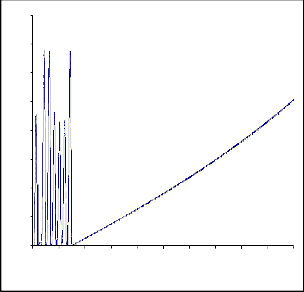
ISSN 2229-5518
2.5
0.8
0.7
2
0.6
1.5
0.5
0.4
1 0.3
0.5
0.2
0.1
0
0 0.2 0.4 0.6 0.8 1 1.2
Time(Sec)
0
0 0.1 0.2 0.3 0.4 0.5 0.6 0.7 0.8 0.9 1
Time(Sec)
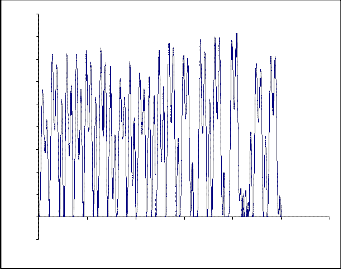
Fig.16 Particle Movement in a 3-phase 500/64 GIB with images for 450KV/AL/4mm/0.3mm radius.
4.5
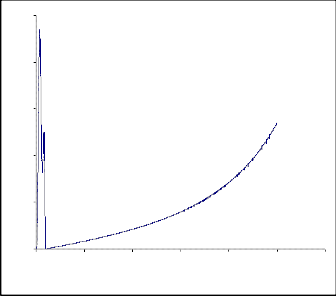
Fig.18 Particle Movement in a 3-phase 500/64 GIB with images for 500KV/Cu/4mm/0.3mm radius
IV. CONCLUSIONS
4
3.5
3
2.5
2
1.5
1
0.5
0
-0.5
0 0.2 0.4 0.6 0.8 1 1.2
Time(Sec)
An uncharged metallic particle resting on bare electrode in a Gas Insulated System will gradually acquire charge due to the application of electric field around it. The charge accumulated is a function of Electric field, shape, size and orientation of the particle. When electrostatic force exceeds the gravitational and drag forces the particle lifts from its position. A further increase in the applied voltage makes the particle move into the inter electrode gap in the direction of applied field. This increases the probability of a flashover. The motion pattern of different metallic particles under different AC voltages been
investigated in a three phase common enclosure for a pressure
Fig.17 Particle Movement in a 3-phase 500/64 GIB with images for 500KV/AL/4mm/0.3mm radius
of 3 bar. The macroscopic electric field at the surface of the enclosure for the 3-phase system is calculated in Cartesian coordinates. The electric field has been used to determine the charge as well as the force on the particle. The radial movement is calculated using the standard equation of motion. It can be noted that aluminum particles are more influenced by the voltage than copper particles due to their lighter mass. This results in the aluminum particle acquiring greater charge-to-
mass ratio. The present work deals with the movement of a
IJSER © 2012
http://www.ijser.org
The research paper published by IJSER journal is about Modelling and Simulation of Trajectories of a Wire Like Particle in a Three Phase Common Enclosure Gas Insulated Busduct (GIB) with Image Charges 9
ISSN 2229-5518
wire like particle when the Image Charge Effect in a Three
Phase GIS is taken into consideration.
V. REFERENCES
1) CIG& Working Group 15.03, “Effects of Particles on GIS Insulation and the Evaluation of Relevant Diagnostic Tools,” CIGRE 1994 Session, August 28 -September 3, 1994.
2) N-J. Ftlici, “Forces et charges de petits objets en contact avec une tlectrode affectke d‟un champ Clectrique,”Revue GCnCrale de L„tlectricitt, pp. 1145-1160, Octobre 1966.
3) A.H. Cookson, R.E. Wotton, “Movement of Filamentary Conducting Particles Under AC Voltages in High Pressure Gases,” International Symposium Hochspannungstechnik Zurich, 1975.
4) M.E. Holmberg, M.L-A. Sjoberg, A.E. Vlasths, “Identification of Metallic Particles in GIS by Statistical Analysis of Acoustical Measurements and Computer Simulations,” 9th International Symposium on High Voltage Engineering, Graz, Austria, August
1995.
5) Westinghouse Research and Development Center, “Investigation of High Voltage Particle-Initiated Breakdown in Gas Insulated Systems,” EPFU Project 7835 Report, Pittsburgh, Pennsylvania, March 1979.
6) F.A.M. Rizk, C. Masetti, R.E Comsa, “Particle-Initiated Breakdown in SF6 Insulated Systems under High Direct Voltage,” IEEE Transactions on Power Apparatus and Systems, Vol. PAS-
98, No. 3, May/June 1979.
7) M. Wohlmuth, “Measurement and Calculation of Lift-off Fields and Charges for Free Moving Particles,” 10 Int. Conf. on GD, Swansea, pp. 414, 1992.
8) H.D. Schlemper, K. Feser, “Estimation of Mass and Length of Moving Particles in GIS by Combined Acoustical and Electrical PD Detection,” Conference on Electrical Insulation and Dielectric
Phenomena (CEIDP), San Francisco, CA, USA, October 1996.
IJSER © 2012
http://www.ijser.org























